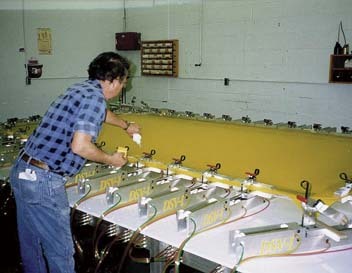Articles
Published
19 years agoon

Screen printing is a highly diverse and continually changing industry. However, in recent years, many people have commented that some of the changes now taking place in the world of graphic arts are threatening the future of screen printing. Is the technological transformation we”re experiencing really any different than what the screen industry has faced in the past? I would argue that it is not.
It”s undeniable that screen-printing markets have changed, especially during the past decade. But the results have not quite worked out the way that many had predicted. In this discussion, we”ll look at some of the most significant alterations that screen printers have faced and consider what further changes await our industry in the future. The ongoing, yet still evolving, relationship between digital- and screen-printing technologies will be one of the primary issues we assess.
The beginning of the end?
In 1993, as a newly graduated mechanical engineer at Swansea University in the United Kingdom, I was offered the opportunity to carry out three years of research for a Ph.D. in screen printing. The focus of this research was to develop a high-speed alternative to what were considered the well understood and controlled conventional and rotary screen-printing processes.
The research project was funded by the British government with the backing of the Screen Printing Association in the UK and several industry vendors. The project was inspired, to a large degree, by what appeared to be an imminent threat looming over the screen-printing industry. Printers and industry manufacturers/suppliers were concerned that digital printing was going to eliminate the graphics screen-printing sector within years, and those involved with the industry wanted to improve screen-printing technology in order to fend off this upstart enemy process.
Within weeks of starting the research project, it became clear that many of the fundamental technologies necessary to create a faster screen-printing system were not in place. Much of the technology was based on historical principles and practices that no longer related to the changing modern screen-printing industry. This led to a redirecting of the project to more fundamental issues, some of the results of which I”ve related to Screen Printing readers in previous articles (see “Mesh Movement and Its Impact on Screen Tensions,” part 1 in Mar. ”03, page 44, and part 2 in Apr. ”03, page 52; “Forecasting the Future of Screen-Printing Technology,” Aug. ”03, page 46; and “Putting Theory into Practice,” May ”04, page 38).
In the early ”90s, the manufacturers of digital-printing equipment were starting to make an impact within the graphics industry, especially for short-run work. At that time, it was estimated that digital technologies would at least double in speed every year for at least the next five, causing a significant growth in the percentage of graphics jobs done digitally.
Now, more than a decade later, the screen-printing industry is still here and going strong. Digital has not taken over the world of printing, and it is unlikely that this technology ever will do so. Instead, digital imaging has become a partnering print process for traditional technologies, such as screen printing. Digital printing has led to significant changes in the screen industry, and it has virtually eliminated some application areas previously reserved for screen printing, such as billboards and fleet graphics. But at the same time, new screen-printing applications have emerged, and these, coupled with the historical strengths of the screen process, lead to a promising future outlook for many segments of our industry.
Retracing the trail of transformation
The rapid improvement in digital-printing technology, particularly inkjet printers, was a wake-up call for the screen-printing industry, so printers, manufacturers, and suppliers began to attack the issues facing them. Among the developments to emerge from this period was new understanding about practical screen tensions for production.
It started as a “my tension is higher than yours” contest in which printers strove to achieve peak tension levels that often were excessive. Today, few printers still use such high tensions. However, the quest for those high tensions forced improvement of stretching technology (Figure 1) and led manufacturers to develop new mesh fabrics and manufacturing methods, improved stencil systems, and better frame technology. Working with such high tensions also lowered the range of variability and acceptable tolerances that printing equipment had to support, leading to more accurate and stable presses. Each one of these developments alone would not be the salvation of screen printing, but, together, they helped to considerably improve print consistency (a major customer concern), reduce waste levels and reprint rates, increase printing speeds, and retain market share for screen printers.
It was essential for screen printing to reduce costs, waste, and delivery times while increasing consistency if it were to compete with a process that could turn a design into finished prints in hours rather than days. The key was for screen printers to become substantially more efficient. One way in which many shops achieved this was by making a concerted effort to switch to UV-curable inks and multicolor inline printing technology (Figure 2) in order to produce finished process-color graphics in one pass. Automation also found its way into the screen department, with automatic screen-cleaning and reclaiming systems, as well as automatic coaters. This automation did mean significant investment for screen printers, but this was offset with the reduced labor and waste costs, plus higher consistency, that resulted.
UV-curable inks were developed and optimized for screen printing, streamlining the printing process and increasing consistency for many applications. Interestingly, UV inks have since become accepted technologies in other print processes, such as flexography, offset lithography, and digital printing. This convergence of technologies also is represented in the increase in narrow to mid-width web presses that often combine rotary screen printing with flexography.
In some respects, digital printing failed to live up to the early hype. Mechanical and physical limitations in the ink-transfer mechanisms prevented print speeds from increasing as rapidly as expected. High initial ink costs, coupled with the frequent and expensive maintenance required on many early digital printers, reduced anticipated cost benefits and slowed the advancement of digital machines into the market. Computer power and hardware/software compatibility issues also held digital-printing technology back. Additionally, the workflow for digital printing was unfamiliar to the traditional printing companies being targeted as customers for the technology, and this workflow took time to gain acceptance.
Besides these issues, the early implementation of digital printing also was hindered by the limited range of ink systems and substrates that the equipment would support. Many machines relied on ink systems that provided little to no durability outdoors, required specially coated substrates, and produced prints that often needed a protective overlaminate. These ink and media constraints also led to higher consumables costs that worked against the faster adoption of digital printing by more graphics producers.
Together, these early challenges faced by digital-printing technology gave the screen-printing industry valuable time to develop and adjust to the evolving marketplace. By the time the developers of inkjet technology

Subscribe

Magazine
Get the most important news
and business ideas from Screenprinting Magazine.
Most Popular
-

 Art, Ad, or Alchemy2 months ago
Art, Ad, or Alchemy2 months agoF&I Printing Is Everywhere!
-

 Case Studies1 month ago
Case Studies1 month agoHigh-Density Inks Help Specialty Printing Take Center Stage
-

 Andy MacDougall2 months ago
Andy MacDougall2 months agoFunctional and Industrial Printing is EVERYWHERE!
-

 Columns2 weeks ago
Columns2 weeks ago8 Marketing Mistakes Not to Make When Promoting Your Screen Printing Services Online
-

 Editor's Note2 weeks ago
Editor's Note2 weeks agoLivin’ the High Life
-

 Marshall Atkinson2 weeks ago
Marshall Atkinson2 weeks agoHow to Create a Winning Culture in Your Screen-Printing Business
-

 Thomas Trimingham2 months ago
Thomas Trimingham2 months ago“Magic” Marketing for Screen Printing Shops
-

 News & Trends1 month ago
News & Trends1 month agoWhat Are ZALPHAS and How Can You Serve Them in Your Print Business?






